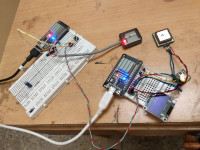Millisecond GPS clock

This project helps you to build cheap yet precisely synchronised millisecond clocks using just an ESP32 and a GPS receiver.
Millisecond GPS clock
I'm working on a pipeline project where by precision measurement of pressure shock waves by two pressure transducers at both ends and then measuring the precise time differences we will try to find out the location of the leakages and the time of leakage etc. The length of the pipeline is about 12 kilometers.The first hurdle in the line was to build two precision clocks playing the same time. We deployed two GPS sensors for uniform time sensing but to build a millisecond precision clock out of that signal we developed an ESP32 and a trick!
In fact it’s not one trick, It’s two tricks one after another to couple the timer clock & the GPS clock coupled together to give the same time.
Now since the GPS clock is same therefore, in two setups, all four clocks (2 Timer clocks and 2 GPS clocks) are synchronized with each other.
Using two sets of Arduino it works but using two ESP8266, it improves in performances like fast synchronization and less gap etc., but using a pair of ESP32 and the result is fabulous! The clock synchronizes fast and the gap reduces to zero pretty quickly.
Tid-bits of the project
Hardware Serial: The softwareserial that is used in Arduino or in ESP8266 is pretty slow compared to the inbuilt hardware serial of ESP32 and that’s why I get better result in ESP32. ESP32 has 3 hardware serials and any pins can be set for the task and for that no extra header files required.Serial1.begin(9600,SERIAL_8N1, RXD1,TXD1); //16,15,13,34,
Serial2.begin(9600,SERIAL_8N1,RXD2,TXD2); //17,12,4,35Once the the GPS starts receiving the NMEA signals, the time is set and the millis() function of the internal timer is deployed for millisecond counting but the GPS clock and the timer clock are not synchronized at this moment.
First Synchronization
When the millisecond gap of the GPS clock and the timer clock approaches to 0 to 1, the timer clock is set by the GPS clock time:if (yy>2000 and year(t)<2000 and ss%5==0 and millis()%1000>=0 and millis()%1000<=1)
{
setTime(hh,mm,ss,dd,mn,yy);
}Second Synchronization:
Now the both the timer clock and the GPS clocks are synchronized but their milliseconds are not synchronized. Therefore, we attempt a second synchronization by adjusting the timer clock again.x = ss*1000+millis();
y = second(t)*1000+millis();
int gap = x-y;
if (gap>=1000 or gap<=-1000)
{
setTime(hh,mm,ss,dd,mn,yy);
digitalWrite(BUTTON_PIN,HIGH);
}Terminal output is the proof
Within a gap of 100 milliseconds all four clocks are synchronized precisely to the GPS values.1st col = 1st ESP32 GPS clock,
2nd col = 1st ESP32 internal timer clock
3rd col = 2nd ESP32 GPS clock,
4th col = 2nd ESP32 internal timer clock
LCD/OLED/TFT display fiasco
The display stalls on any of these display screens. The second digit does not move further. On old 16 char x 2 col, LCD screens also the digit hangs. However, the clocks keep on running relentlessly!Philosophy of the project
Once there is a pressure signal generated by any leakages whatsoever, the GPS clock will record the time precisely on both the pressure transducers. The time gap (t = t1 - t2) will indicate the location of the leakage but that’s not our topic here.Schematic
Attached below.Right now the whole thing is under testing.
I hope your readers would love the prospect of this small experiment someday.




Discussion (3 comments)
Bob_L 5 years ago
bera 5 years ago
I'm thinking of recording the first few time stamps on the internal EEPROM of the ESP32.
Bera S
bera 5 years ago
1. I've added an RTC DS3231 now with the ESP32 and then synchronized with the GPS clock. If the clock is fully synchronized in the 2nd phase then the internal LED on [D2 pin] will be lighted up.
2. On the Serial monitor the display becomes live only when the push button is kept pressed. That way you can say it's an event registrer - when the clock will record the moment of event.
All the clocks - GPS clcok, Timer clock and the RTC clock are synchronized with in 100 millisecond - always!!!